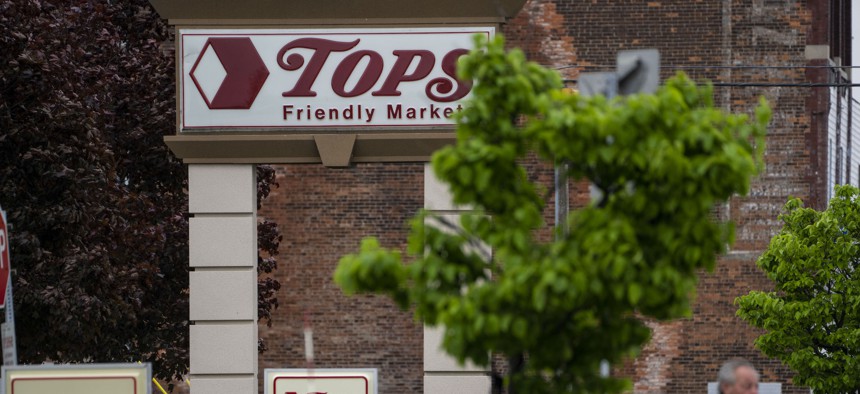Policy
Police could have used New York’s Red Flag law to stop the Buffalo shooting suspect
New York State Police said they did not file for a protection order under the law after they were called to the accused shooter’s school, where they reportedly investigated a “murder-suicide” threat he made.

The Tops Friendly Market in Buffalo where a shooter killed 10 people. Kent Nishimura / Los Angeles Times via Getty Images
The Buffalo shooting suspect who reportedly threatened a murder-suicide less than a year before he shot 13 people, killing 10, at a Tops supermarket on Saturday may have been prohibited from acquiring the firearm he used in the massacre – if law enforcement had pursued the available protections under the state’s Red Flag Law. Per the law passed in 2019, law enforcement, family members or school employees can file for an “extreme risk protection order” that would require a state Supreme Court judge to decide if there is probable cause that the person is likely to seriously harm themself or another individual.
Questions were raised about why the law wasn’t executed in the wake of Saturday’s shooting after officials revealed that 18-year-old Payton Gendron had made a “generalized threat” of violence in June 2021 while attending Susquehanna Valley High School in his hometown of Conklin. According to The New York Times, citing a law enforcement source, Gendron responded to a school project about his post-graduation plans by stating he wanted to commit a murder-suicide. New York State Police confirmed they responded to the school on June 8 to investigate a “generalized threat” made by a 17-year-old student, who was then taken into custody and transported to the hospital for a mental health evaluation. The agency, which would not say whether Gendron was the student, citing privacy reasons, said in an email to City & State it did not apply for an extreme risk protection order against the student and noted the threat was general in nature and did not target the school or anyone in particular.
Months later, sometime earlier this year, Gendron purchased what was described by Gov. Kathy Hochul as an “AR-15-style” rifle from Vintage Firearms in Endicott. The store owner, Robert Donald, told NPR Gendron’s background check showed nothing that would have prevented him from legally selling him the gun.
Assembly Member Jo Anne Simon, who sponsored the Red Flag legislation, expressed disappointment that law enforcement did not pursue a protection order after the June incident, noting the law is set up so that a judge can make the final determination if there is probable cause to believe a person is likely to engage in violence.
“He was brought in last year. There was a complaint he had threatened violence last year when he was in high school, so law enforcement should have applied for an extreme (risk) protection order because he clearly demonstrated an intent to commit violence to himself or others,” Simon told City & State, adding that she is considering calling for a public education campaign to heighten the public’s awareness of the law in the wake of the shooting. “I can’t tell you how many people I’ve seen on Twitter saying ‘it’s not working.’ It’s not working unless people know how to use it.”
Under an extreme risk protection order, a person would be flagged in the FBI database used by gun sellers, prohibiting them from buying a firearm. Law enforcement, such as a sheriff’s office, must confiscate any firearms they currently possess, along with their firearm license. Within three to six days of the initial “temporary order” being issued, a hearing must be held to determine if a final extreme risk protection order should be granted. While the order stays in effect for one year, law enforcement must hold any surrendered firearms for three years after the order goes into effect.
State Sen. Brian Kavanagh, who sponsored the bill in the upper chamber, said a thorough investigation needs to be conducted to determine “what specifically the evidence was last June and whether there was a conscious decision about whether a Red flag order was appropriate,” he told City & State. Regardless of the results of the investigation, “this is an important moment to remember that we've got a law in the books that is a very effective way to determine when someone is identified as being a danger to themselves or to others,” he said.
Since the law was enacted on August 25, 2019, New York courts have granted 875 temporary orders of protection and 589 extreme risk protection orders under the legislation – and the number of orders issued by each county varies widely, according to data from the Office of Court Administration. No orders have been granted in Manhattan, and just two temporary protection orders have been granted in Brooklyn. Suffolk County has the largest number of extreme risk protection order approvals of any by far, with 116. Sgt. Paul Spinella, a spokesperson for the sheriff’s department, which is responsible for executing the orders, told City & State that all but two of the petitions for protection orders were filed by law enforcement.
“Most of them probably come from someone calling 911. And then based on that, the law enforcement agency files for the petition for the (extreme risk protection order),” Spinella said.
NEXT STORY: Debating the impacts of bail reform

